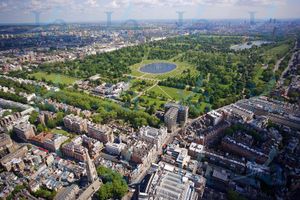Collaborative Design Planting Design Working Group 11: Difference between revisions
No edit summary |
No edit summary |
||
| Line 1: | Line 1: | ||
---> back to group page [[Planting_Design_2013_-_Working_Group_11|working group 11]] | ---> back to group page [[Planting_Design_2013_-_Working_Group_11|working group 11]] | ||
'''Hyde Park, London, England''' | |||
Revision as of 23:15, 13 January 2014
---> back to group page working group 11
Hyde Park, London, England
| Name | Hyde Park | |
| Location | Westminster, London | |
| Country | England | |
| Authors | Andra Spornic, Andreia Oshiro Gama, Masaki Ikeda | |

| ||
|
| ||
Landscape and/or urban context of your case
- Biogeography
Located in Westminster, central part of London, Hyde Park is one of the Royal Parks and also one of the largest in the city. Alone it has an extension of 142 ha and is connected to Kensington Gardens with 111 ha on west side, in a quite flat surface. The combined area of 253 ha is a little smaller than Central Park in New York with 341 ha.
The Long Water and the Serpentine are recreational lakes, which together divide the park in two, and represent an important identity element. The bathing area, known as the Lido, is a rectangular area about 100 m long and 30 m wide.
There is a variety of species of fauna and flora, which has been increased since the implementation of a meadow area, in reference to earlier times. The trees, shrub beds and herbaceous plantings offer a rich habitat for song birds, bees, butterflies and other insects, bats, ducks, and others. Some exotics species can be seen occasionally, like black swan, a buzzard and Egyptian geese.
- Cultural features
Hyde Park has been place for famous rock concerts and outdoor experience, crowding up to 500.000 people.
The site of Tyburn gallows, in former times used for public executions, today it is a Speakers’ Corner, where people discuss and debate in public.
Special attractions for visitors:
- The Diana Memorial Fountain - opened in 2004.
- The Diana Princess of Wales Memorial Walk - a seven-mile-long walk, charted by 90 plaques set in the ground, that takes visitors within sight of famous buildings and locations related to the Princess during her life.
- Serpentine Lido – a beach like area which has been used over 100 years for swimming, relaxing, sunbathing and playing.
- 7th July Memorial - permanent memorial to honor the victims of the 7 July 2005 London
- Royal Gun Salutes – are fired to mark special royal occasions.
Hyde Park has a wide range of facilities: cafes and restaurants, a children's playground and the Lookout, a former police observation point which is now an education center for nature and wildlife, toilets (also for disabled people).
There is a range of leisure activities like informal games, swimming and horse riding. Cycling, roller-blading and skateboarding are possible in all roads and cycle tracks.
The park has also sport facilities for Football, tennis, lawn bowls, boating, and exercise equipment in the Senior Playground. The paths and grass areas are intensive used for walking, jogging and running.
- Overall character
It is often thought that the Kensington Garden is a part of the Hyde Park, but they are categorized as different parks.
- History and dynamics
The oldest part of the park is the site of the manor of Westminster Abbey. The area of the manor was 1 hyde (60 to 120 acres), which the name of the park came from originally. In 1536, King Henry Ⅷ purchased the land from Westminster Abbey. The layout of the park was built from Decimus Burton’s design in 1820’. In 1851, the Great Exhibition was hold in the park as the most important event . The Crystal Palace was constructed at the time from the design of Joseph Paxton. However it was lost by a fire after it moved to Sydemham Hill in South London, after the Great Exhibition.
- Illustration: Map; sketches; short descriptive analyses
What are the objectives of your design?
Please give a short written argumentation (not more than 150 words). It is ok if you have different or even contradicting objectives within your group. Just make it explicit at the beginning of your process
Analytical drawings
Please add four analytical sketches/drawings (or montages/schemes) of your case. Every group member needs to contribute at least one drawing.
- Analytical Drawings
- Yourfilename1.jpg
analytical drawing 1
- Yourfilename2.jpg
analytical drawing 2
- Yourfilename3.jpg
analytical drawing 3
- Yourfilename4.jpg
analytical drawing 4
Projective drawings
Please add four projective sketches/drawings (or montages/schemes), of course with an emphasis on planting design/vegetation aspects. Every group member needs to contribute at least one drawing representing his/her individual ideas.
- Projective Drawings
- Yourfilename1.jpg
projective drawing 1
- Yourfilename2.jpg
projective drawing 2
- Yourfilename3.jpg
projective drawing 3
- Yourfilename4.jpg
projective drawing 4
Design Synthesis
Please analyse the individual approaches presented so far and evaluate their strengths and weaknesses (you may use the SWOTanalysis model). Try to create a synthesis and represent it with a plan and some sketches. You can still use drawings/sketches.
- Design Synthesis Drawings
- Yourfilename1.jpg
synthesis drawing 1
- Yourfilename2.jpg
synthesis drawing 2
- Yourfilename3.jpg
synthesis drawing 3
- Yourfilename4.jpg
synthesis drawing 4
Summary of the collaborative process
Please reflect on your collaborative design process. Which potentials have you encountered? What was most difficult? What does collaborative design mean for you? (approx 150 words).
Image Gallery
You may add a series of images/photos in addition to the sketches/drawings
- Image Gallery
- Yourfilename1.jpg
image 1
- Yourfilename2.jpg
image 2
- Yourfilename3.jpg
image 3
- Yourfilename4.jpg
image 4
References
* Please make sure that you give proper references of all external resources used.
* Do not use images of which you do not hold the copyright.
* Please add internet links to other resources if necessary.
About categories: You can add more categories with this tag: "", add your categories